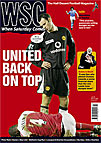 Whatever happens to Diego Maradona, the people of Naples will still love him and the city is the first European destination for a travelling exhibition about him, as Paul Virgo reports
Whatever happens to Diego Maradona, the people of Naples will still love him and the city is the first European destination for a travelling exhibition about him, as Paul Virgo reports
Today Diego Maradona is an obese, emotionally fragile, addiction-ridden wreck. Which is very sad. But it also makes it easier for England fans to drop the 1986 World Cup grudge and allow themselves to appreciate his genius. Anyone wanting to completely purge their soul of rancour can pay a visit to M10, an exhibition devoted to his life, currently in Naples.
Maradona himself insisted Naples be the first place outside Argentina to see the show. Rightly so. Maradona had the city in a continual frenzy during his 1984 to 1991 spell at Napoli, during which years he secured the greatest achievements of his career – two Italian league titles, the UEFA Cup and, of course, the World Cup. Naples and its murky underworld spoilt and suffocated the player, helping him develop the cocaine addiction that has become such a problem. But it’s also true that Maradona felt at home in this anarchic, passionate setting, which brought out the best in him on the field. As well as adoration for him, Neapolitans have a great sense of pride in having contributed to the making of the world’s best ever footballer. Maybe he would be a healthier person if he had never moved to Napoli, but would he have hit the same highs?
Neither party has been the same since 1991, when Maradona fled town after testing positive for cocaine. The player is how he is and Napoli’s decline culminated with bankruptcy last summer and relegation to the third division. M10’s venue is a short walk from the San Paolo stadium, where Napoli struggle to make an impression in Serie C1. The love is still requited and continually reinforced by nostalgia, although this didn’t stop a few scallywags living up to the city’s bad name by trying to steal exhibits on the opening day.
M10 charts Maradona’s story from childhood, with a fascinating range of shirts, trophies and assorted junk, interspaced with photos and video footage. It opens with a reconstruction of the humble interior of the Buenos Aires shantytown shack he grew up in. Next comes the sort of stuff you’d expect to find at the bottom of a drawer at his mum’s house, such as faded membership cards of the Argentinos Juniors youth team, his childhood kit and boots, a 1974 Evita Peron youth championship winners’ medal and the telegram of his first call-up for the national squad in 1978.
The video footage is stunning, with absurd feats of dribbling, shooting, goalscoring and goalmaking. There are also extraordinary scenes of a fight between Maradona and the whole Athletic Bilbao team in the 1984 Spanish Cup final, when he was at Barcelona.
Maradona has rubbed shoulders with other arenas’ greats. There’s a Michael Schumacher 1994 World Champion cap and tennis rackets from Goran Ivanisevic and Gabriela Sabatini. Freddie Mercury, Brian May, Bono and Fidel Castro chip in, and there’s a signed copy of Eddy Grant’s 1980 album My Turn To Love You.
Silverware includes the FIFA Player of the Century award, a copy of the UEFA Cup, the France Football honorary Ballon D’Or, which he was given for his career in 1995, and his scudetto and UEFA Cup medals. Oddly, there is also a miniature European Cup replica given to him by Arrigo Sacchi – maybe Sacchi wanted to remind the Argentine that there’s one trophy he’d won and Maradona hadn’t.
Off the field he is portrayed as a kind, fun-loving family man. No reference is made to his illegitimate Neapolitan son, who is also called Diego Maradona and is currently appearing on an Italian reality TV football show. This is not so surprising given that Maradona’s wife supplied material for the exhibition.
The 1986 World Cup quarter-final is given ample space. You can admire a shirt, the boots and captain’s armband he wore that day. The footage is edited to show lots of fouls on him by Steve Hodge before the Hand of God goal. But fair dues, the first goal is repeated three times from different angles to show him using his hand, the same treatment given to the “Goal of the Century” that followed. There is also an England shirt from that match, billed as Gary Lineker’s though Maradona is known to have swapped with Hodge, who owns the shirt Diego wore in the second half. Unlike many of the others donated by rivals, it doesn’t have a “with love and esteem” message on it. Funny that.
From WSC 217 March 2005. What was happening this month